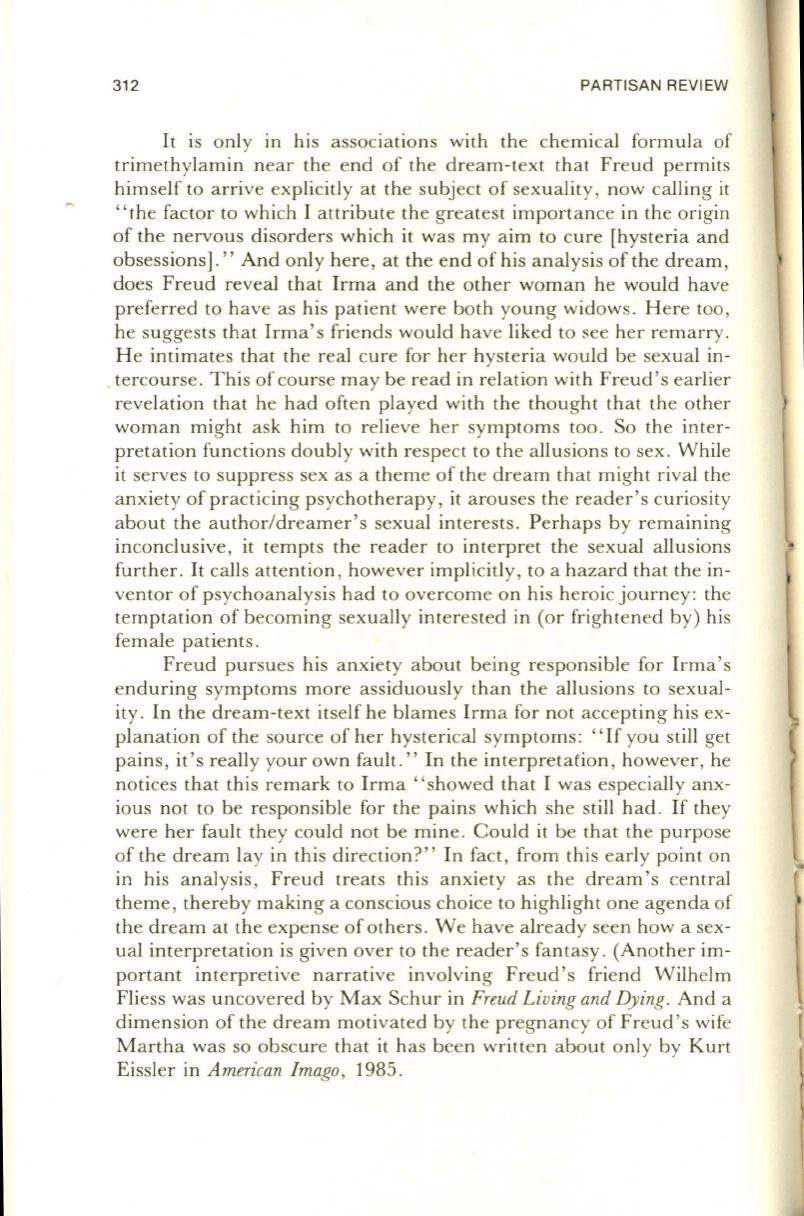
312
PARTISAN REVIEW
It
is only in his associations with the chemical formula of
trimethylamin near the end of the dream-text that Freud permits
himself to arrive explicitly at the subject of sexuality, now calling it
"the factor to which I attribute the greatest importance in the origin
of the nervous disorders which it was my aim to cure [hysteria and
obsessions]." And only here, at the end of his analysis of the dream,
does Freud reveal that Irma and the other woman he would have
preferred to have as his patient were both young widows. Here too ,
he suggests that Irma's friends would have liked to see her remarry.
He intimates that the real cure for her hysteria would be sexual in–
tercourse. This of course may be read in relation with Freud's earlier
revelation that he had often played with the thought that the other
woman might ask him to relieve her symptoms too. So the inter–
pretation functions doubly with respect to the allusions to sex. While
it serves to suppress sex as a theme of the dream that might rival the
anxiety of practicing psychotherapy, it arouses the reader's curiosity
about the author/dreamer's sexual interests. Perhaps by remaining
inconclusive, it tempts the reader to interpret the sexual allusions
further. It calls attention, however implicitly,
to
a hazard that the in–
ventor of psychoanalysis had to overcome on his heroic journey: the
temptation of becoming sexuall y interested in (or frightened by) his
female patients.
Freud pursues his anxiety about being responsible for Irma 's
enduring symptoms more assiduously than the allusions to sexual–
ity. In the dream-text itself he blames Irma for not accepting his ex–
planation of the source of her hysterical symptoms:
"If
you still get
pains, it's really your own fault." In the interpretafion, however, he
notices that this remark to Irma "showed that I was especially anx–
ious not to be responsible for the pains which she still had. If they
were her fault they could not be mine. Could it be that the purpose
of the dream lay in this direction?" In fact , from this early point on
in his analysis, Freud treats this anxiety as the dream's central
theme, thereby making a conscious choice to highlight one agenda of
the dream at the expense of others. We have already seen how a sex–
ual interpretation is given over to the reader's fantasy. (Another im–
portant interpretive narrative involving Freud's friend Wilhelm
Fliess was uncovered by Max Schur in
Freud Living and Dying.
And a
dimension of the dream motivated by the pregnancy of Freud's wife
Martha was so obscure that it has been written about only by Kurt
Eissler in
American Imago,
1985 .


